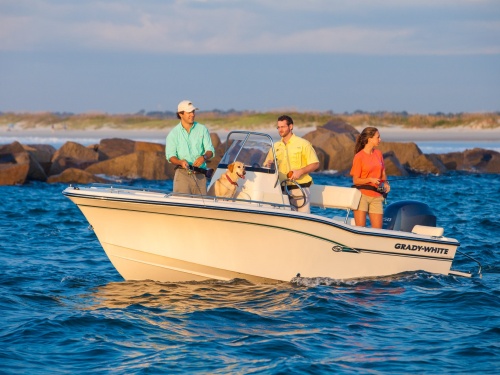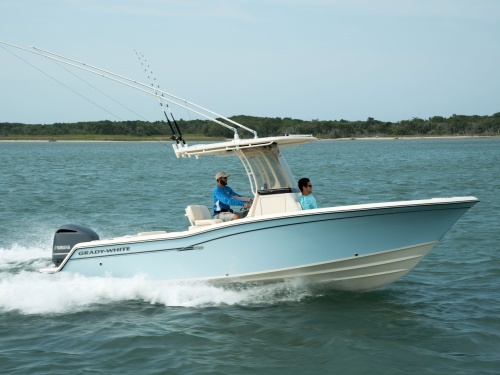Access More Boat Tests
Already have an account? Login
Grady-White Fisherman 216 (2018-)
1 x 200 hp Yamaha F200
Brief Summary
Grady-White's Fisherman 216 is a dual-purpose center console that combines her builder's famous fishability with extra crew comfort. She's designed for fishing, but also for swimming, waterskiing and simply day cruising. Her enclosed head compartment (a portable toilet is standard) will also be welcomed by the whole family.
She comes standard with enough fishing amenities to satisfy all but the most fanatic angler, and can also be customized from a list of options into a comfortable family dayboat, too. Port and starboard stern platforms facilitate boarding from dockside or from the water; a four-step swim ladder is standard.
Key Features
- Nonskid fiberglass liner
- Stainless steel through-hull fittings
- Automatic bilge pump (1,100 GPH) (4,164 LPH)
- Swim platforms - aft port and starboard extensions with starboard ladder
- Forward anchor locker with rode storage
- 80-gallon (303 L) fuel tank
- 316 grade stainless steel steering wheel with knob
- Scratch resistant acrylic windshield with handrail
Test Results
| RPM | MPH | Knots | GPH | MPG | NMPG | STAT. MILE | NM | dBa |
|---|---|---|---|---|---|---|---|---|
| 600 | 2.8 | 2.4 | 0.4 | 6.9 | 6 | 495 | 430.4 | 61 |
| 1000 | 4.2 | 3.7 | 0.8 | 5.3 | 4.6 | 378 | 328.7 | 61 |
| 1500 | 5.9 | 5.1 | 1.3 | 4.5 | 3.9 | 327 | 284.1 | 70 |
| 2000 | 7.5 | 6.5 | 2.1 | 3.5 | 3.1 | 255 | 222.1 | 72 |
| 2500 | 8.5 | 7.4 | 3.3 | 2.6 | 2.3 | 188 | 163.7 | 75 |
| 3000 | 10.6 | 9.2 | 4.7 | 2.3 | 2 | 162 | 141.2 | 80 |
| 3500 | 20.2 | 17.5 | 5.4 | 3.7 | 3.2 | 269 | 233.6 | 82 |
| 4000 | 26.4 | 23 | 7.4 | 3.6 | 3.1 | 259 | 224.9 | 85 |
| 4500 | 31.5 | 27.4 | 9.4 | 3.4 | 2.9 | 241 | 209.8 | 87 |
| 5000 | 36.1 | 31.4 | 13.2 | 2.7 | 2.4 | 197 | 171.2 | 92 |
| 5500 | 40.2 | 35 | 17.2 | 2.3 | 2 | 169 | 146.8 | 92 |
| 5800 | 42.5 | 36.9 | 19.5 | 2.2 | 1.9 | 157 | 136.6 | 93 |
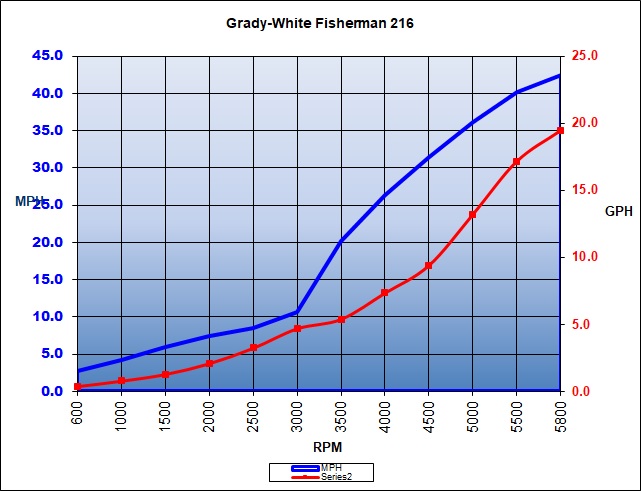
Specifications
| Length Overall | 21' 3" / 6.48 m |
|---|---|
| Beam |
8' 6" 2.59 m |
| Dry Weight |
3,125 lbs. 1,417 kg |
| Tested Weight |
5,063 lbs. 2,296 kg |
| Draft |
16" 40.6 cm |
| Deadrise/Transom | 19 deg. |
| Max Headroom | N/A |
| Bridge Clearance |
7' 7" 2.31 m |
| Weight Capacity | N/A |
| Person Capacity | 8 |
| Fuel Capacity |
80 gal. 303 L |
| Water Capacity |
10 gal. 37.8 L |
| Total Weight |
5,063 lbs. 2,296 kg |
Acceleration Times & Conditions
| Time to Plane | 4.8 sec. |
|---|---|
| 0 to 30 | 10.2 sec. |
| Props | 14 1/2 x 15 Reliance SDS |
| Load | 2 persons, 1/2 of fuel, full water, 593 lbs. of gear |
| Climate | 80 deg., 70 humid.; wind: 5-10 mph; seas: calm |
Engine Options
| Tested Engine |
1 x 200 hp Yamaha F200 |
|---|---|
| Std. Power |
Not Available |
| Opt. Power |
1 x 200-hp Yamaha Four-Stroke 1 x 250-hp Yamaha Four-Stroke |
Captain's Report
 Learn More
Learn More
Watch Our Video
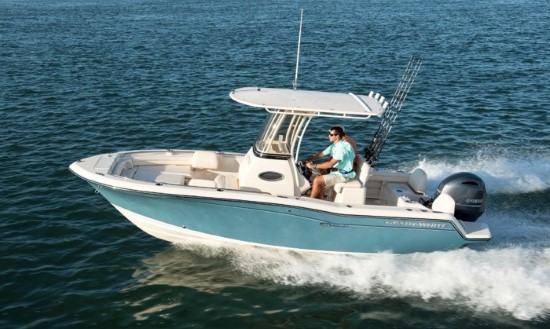
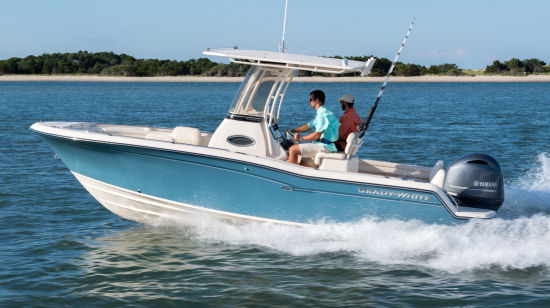
Mission
Grady-White has targeted this boat to several groups of boat owners -- hard-core anglers, casual anglers with families that like to use the boat for watersports and excursions, and people transitioning from other types of boats, including sailboats, sportboats and large cruisers, who want a good, all-around day boat that looks salty and they can be proud to own.
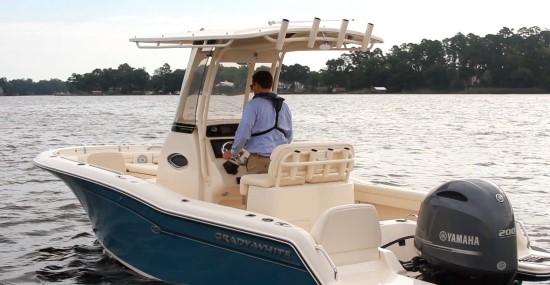
Overview
The Grady-White Fisherman 216 comes standard with family-friendly features, including a head compartment in the console and supportive jump seats at the transom. Add some options and she becomes akin to a sportboat bowrider, with cushioned full-length V-lounges forward, or even a bow-filling sun pad. She has a swimmer-friendly transom with dual molded-in platforms that are a little longer than normal. They also facilitate boarding from dockside.
When it's time to fish, the filler cushion and watersports gear can be left ashore and the Fisherman 216 becomes what her name implies: A no-nonsense fishing boat.
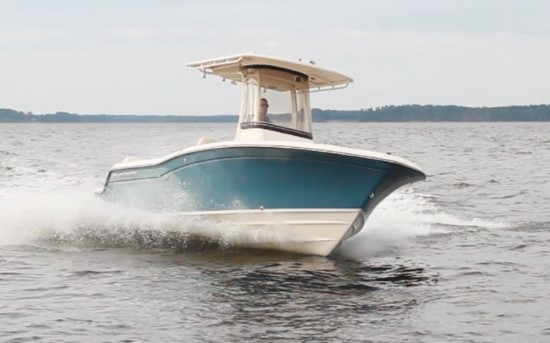
Major Features
- Port and starboard jump seats swivel inboard and out of the way to allow unencumbered passage between the cockpit and the dual stern platforms. When flipped upside-down, the upholstered seat bottoms self-stow, revealing a hard surface with nonskid strips for sure footing.
- V-seats in the bow, which house a pair of insulated fishboxes, can have optional foldaway backrests so that two people can face forward while underway. They are plush. An additional fiberglass insert with cushion can turn the bow into a full sun pad. With the cushions removed, anglers have an elevated casting deck.
- The console houses a lockable head compartment with 4’8” (1.42 m) headroom, a standard portable head, LED lighting, and storage. The molded forward console seat is cushioned and houses an insulated cooler/fishbox that drains overboard.
- The standard helm seat is large enough for two people (sitting or standing); a backrest, flip-up bolster and molded-in footrest are standard. Tackle trays, more lockable storage, a fire-extinguisher holder, and four rocket launcher-style rod holders complete the leaning bar package.
- All deck hardware is marine-grade 316 stainless steel, through-bolted for maximum strength.
- Nothing Drains into the Bilge. The Fisherman 216 has been engineered to be “self-bailing”; this means that not only the cockpit but also all of the fishboxes, coolers, livewells, rod holders, and cup holders have been designed to drain overboard by gravity.
- Secure toe-rails in cockpit allow anglers to feel safe and more secure when leaning over the gunwale trying to land their catch in sloppy conditions.
- Hull design by Ray Hunt & Associates. This is probably the most important feature of all, as few center console builders have hulls designed by the firm that invented the deep-V bottom and has refined it continually for over 50 years. Grady-White calls it their “SeaV2” which signifies that it is a “Continuous variable V” hull. Over numerous tests, we have found it to stay under control, has no bad habits, is forgiving, and is a good compromise between ride and fuel economy and speed.
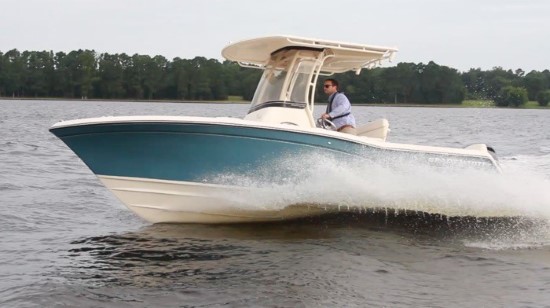
Design and Construction
Grady-White boats are priced near the top of the center console range, where impeccable quality and finish work is expected. The boats are designed and built by craftsmen, many of whom have worked for Grady-White for 20 years or more and know the company’s best practices.
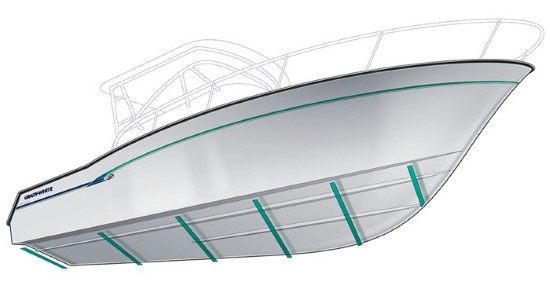
Hand-laid Lamination. The hulls, decks, and major components are hand-laid, using the best resins, fabrics and reinforcement, according to the company. There's no wood in the structural components. Stringers and frames are composite -- fiberglass over structural foam -- and the transom is cored with high-density foam that won't get soggy if water gets in.
Gated Entrance
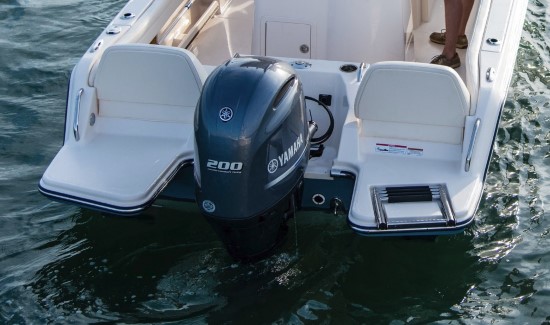
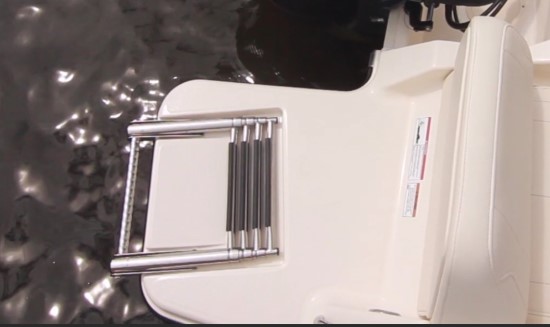
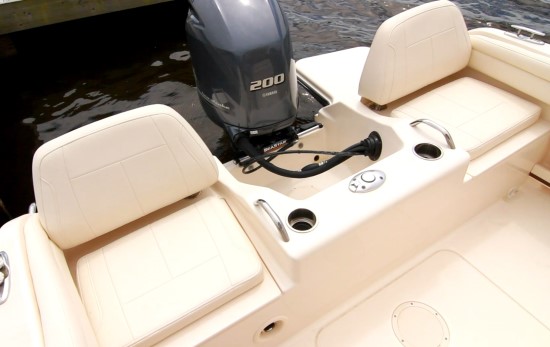
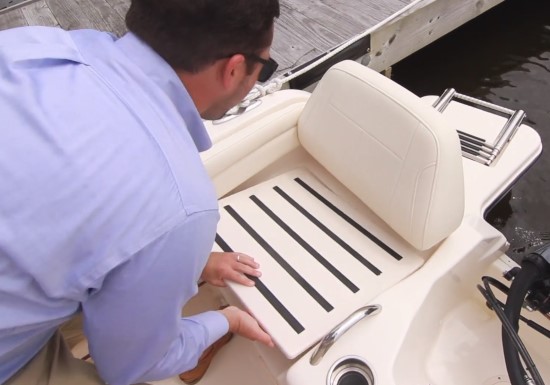
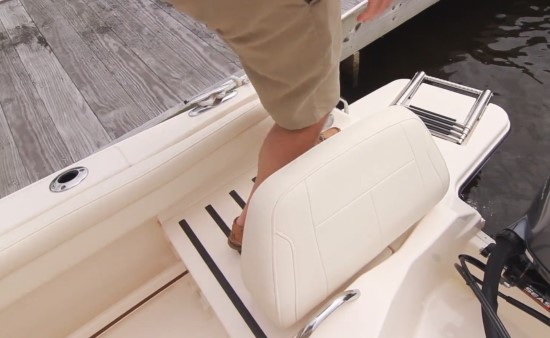
The molded stern platforms are longer than on previous models, and the non-skid on the passageway allows this area to be used for launching watersports. Note that the seat back has been swiveled inboard. This is a functional innovation in this class of boats. The re-boarding ladder has four steps. 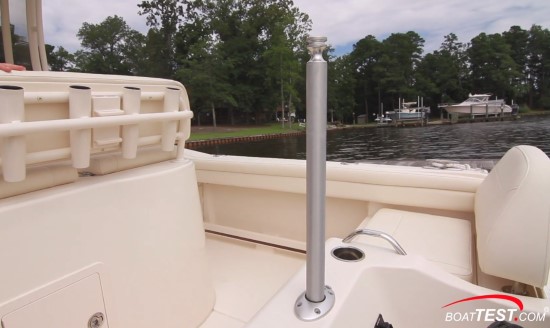
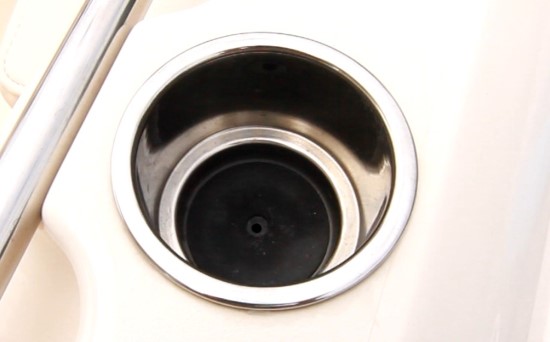
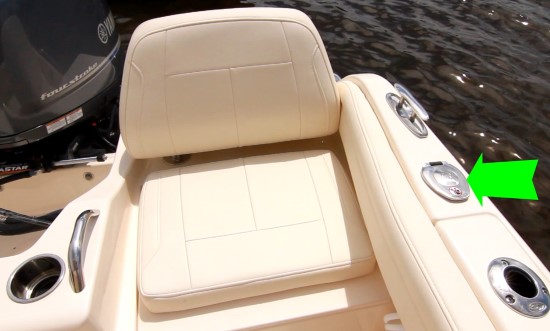
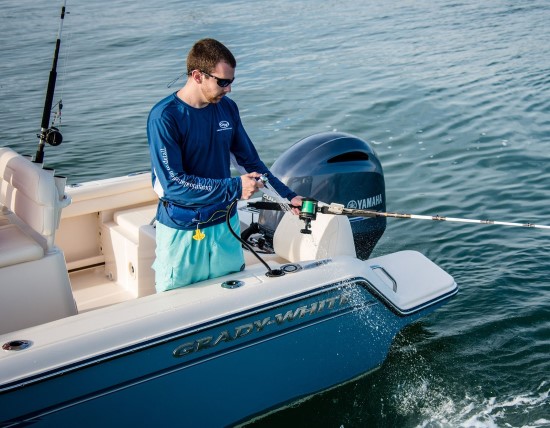
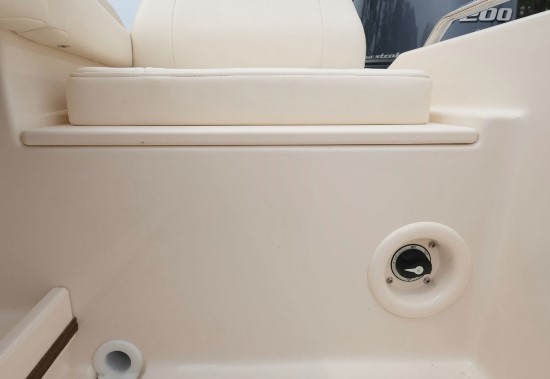
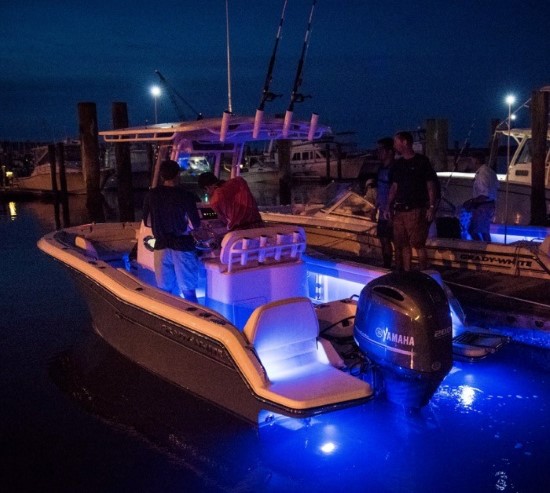
General Design Considerations
The Fisherman 216 has design details that make the boat functional for both fishing and more general use. The first detail is her two swim platforms that are much longer than on previous designs. Second, Grady-White has designed the backs of the jump seats so they swivel out of the way, permitting egress on both sides of the boat to the swim platforms. The cockpit depth ranges from 25” (.64 m) aft to 34” (.86 m) forward.
Fishability. With a hull draft (outboard up) of just 16” (40.6 cm), the Fisherman 216 can get into shallow water to hunt redfish, bonefish, or other species. Her cockpit depth is 25” (63.5 cm) which means the bolster hits the anglers leg at mid-thigh and the sturdy toe rails provide security. Four rod holders are standard.
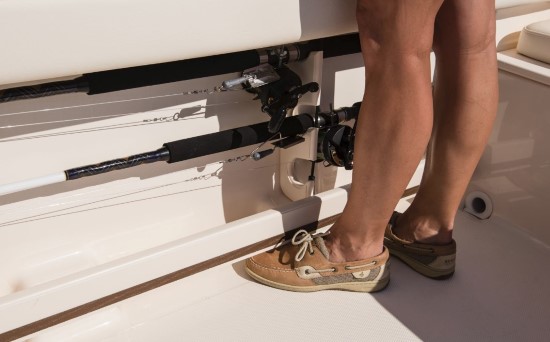
Forward, with the cushions off, the seats/fishboxes provide platforms for casting or netting. The two insulated and self-draining (overboard) 81-quart compartments can be used as fishboxes, beverage coolers or for general storage.
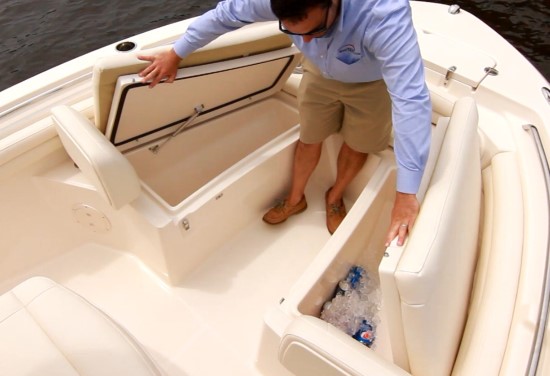
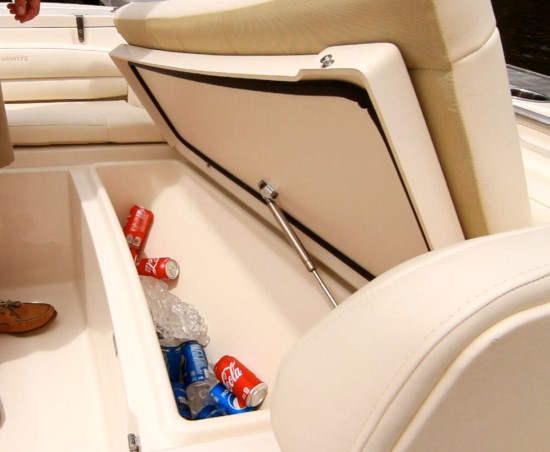
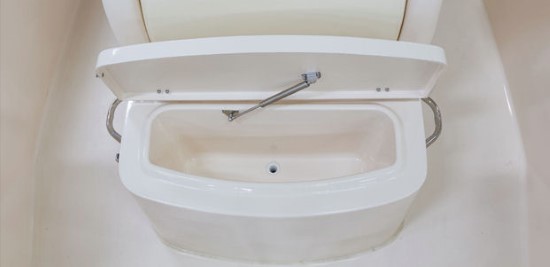
Optional Angling Accessories. For avid anglers we would recommend getting:
- The filler platform that goes between the fishboxes/seats in the bow
- Cockpit bolsters, which are a “must”
- The deluxe lean bar with backrest, 25-gallon (95 L) insulated livewell with full column distribution
- The fiberglass T-top with painted frame, spreader lights, rod holders, overhead equipment box, and windshield.
Our test boat had all of these options installed.
The Helm
As one would expect, the Fisherman 216’s helm has been well-designed. The steering wheel is to port, not in the center as we sometimes see. The compass on the dash forward is aligned with the hub of the wheel, and not centered on the console, as many builders do. The ignition has been placed under the wheel so the kill-switch lanyard is easy at hand, but the ignition key is out of the knee-strike zone. These are all small details, but important ones.
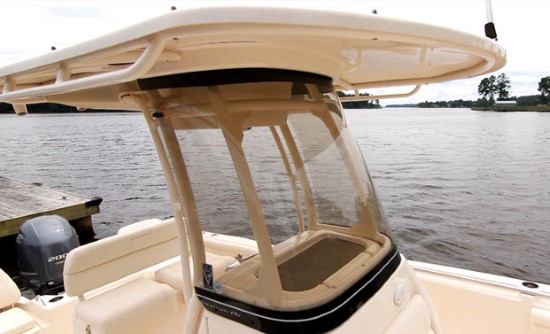
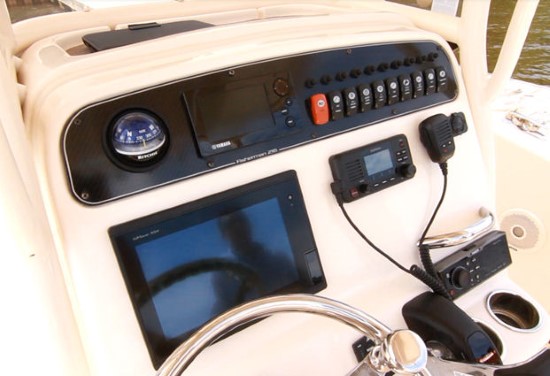
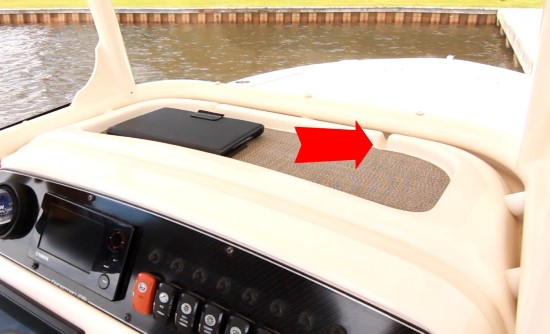
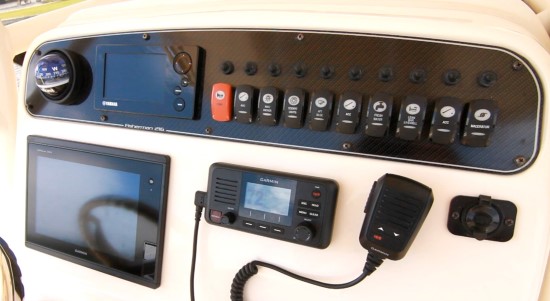
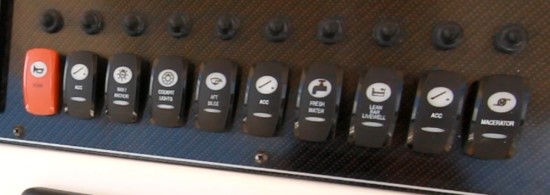
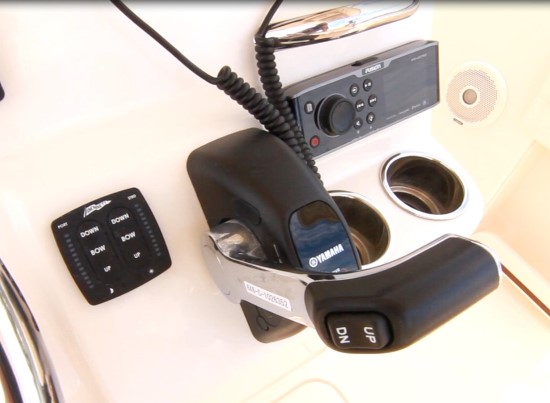
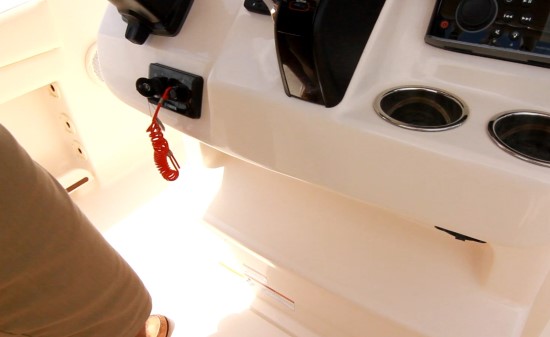
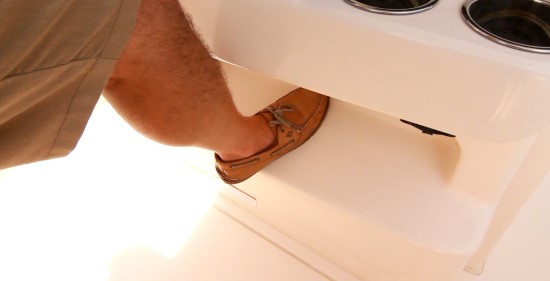
Helm Seating
We think that the Fisherman 216 comes standard with one of the most luxurious center console helm seats in this size and type of boat. Most provide simply a barebones leaning post. The Fisherman 216’s helm seat is built on a sturdy fiberglass base that provides stability as well as being a cabinet for tackle boxes and a structure to hold four rocket launchers.
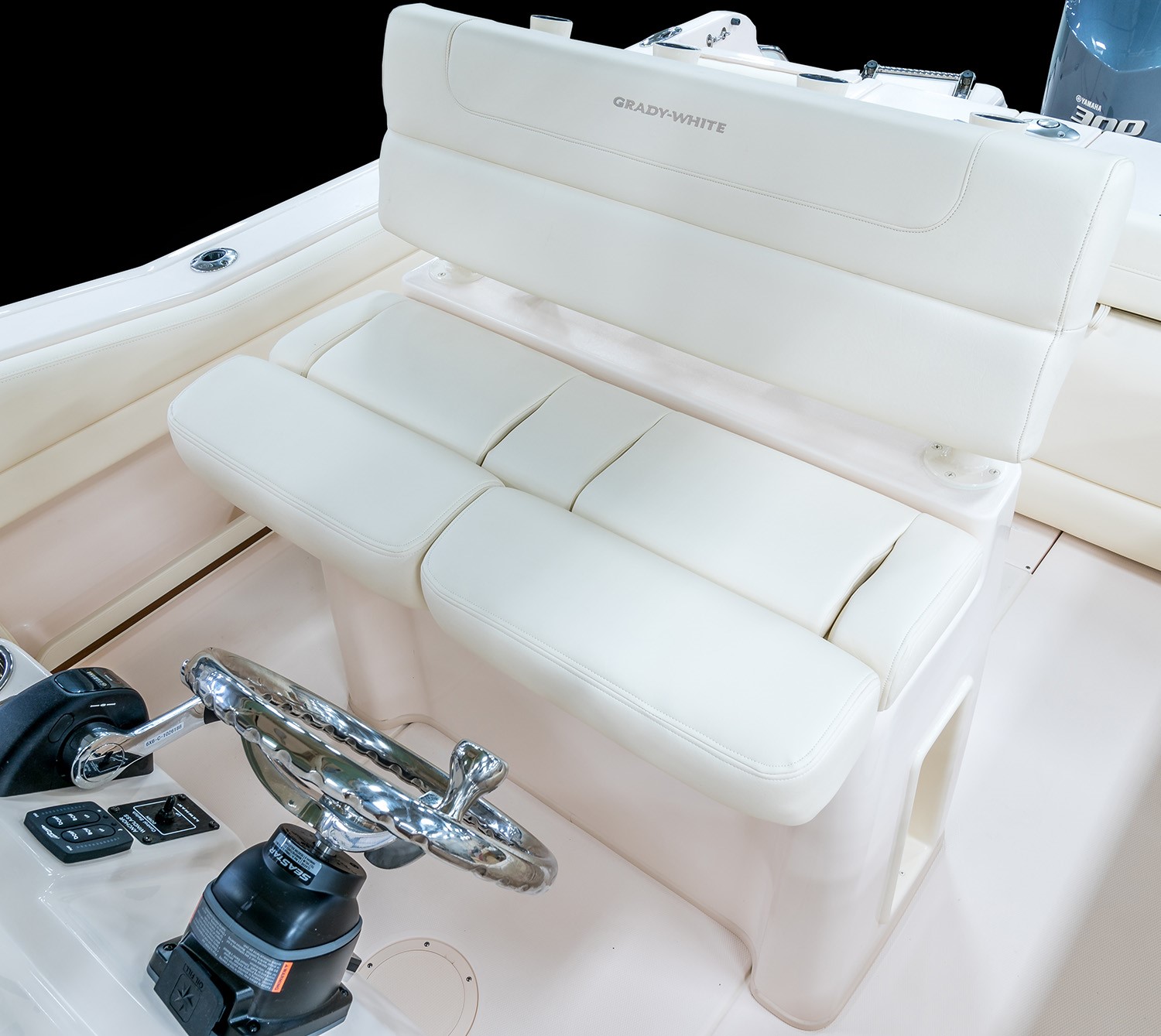
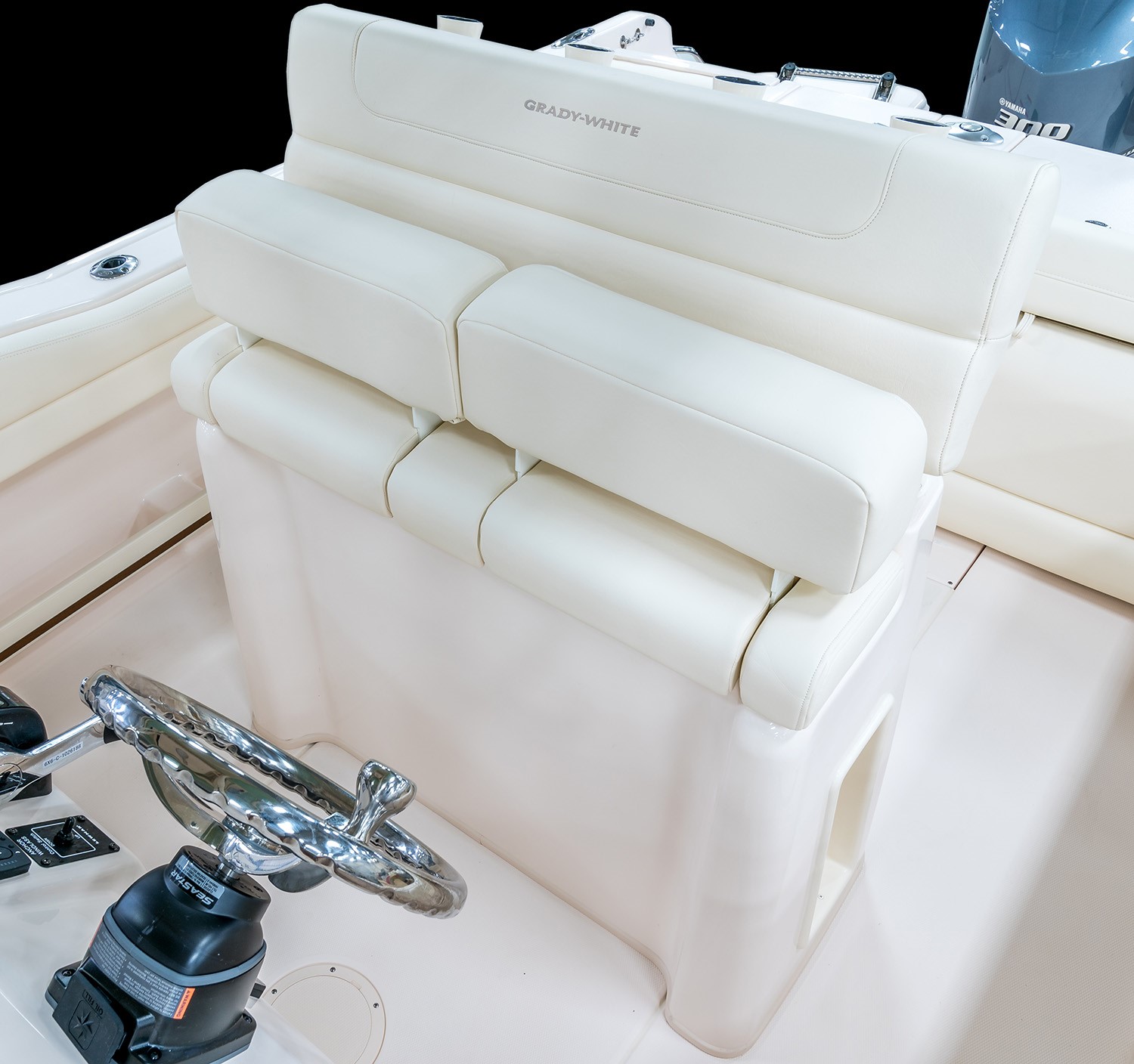
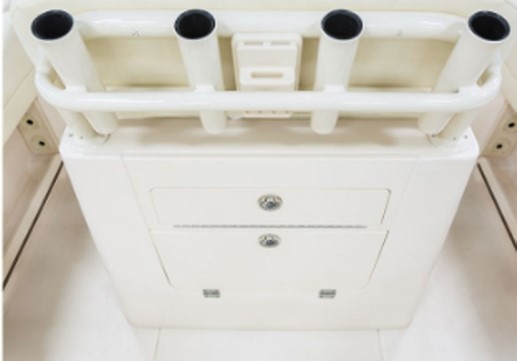
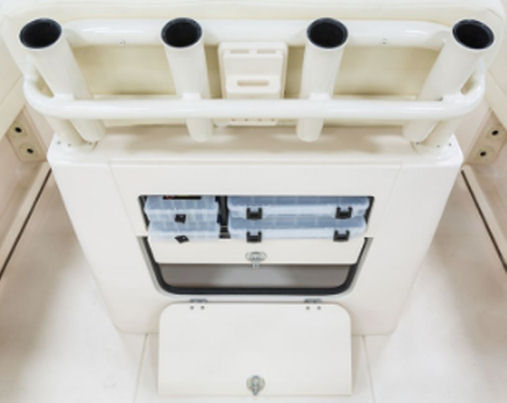
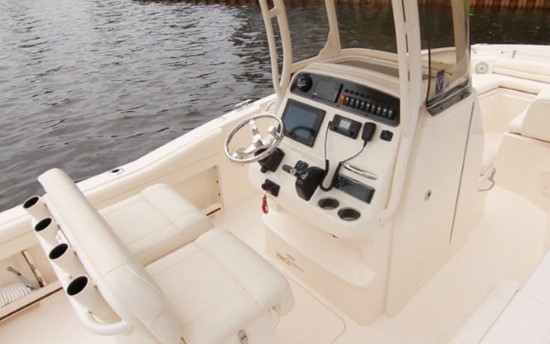
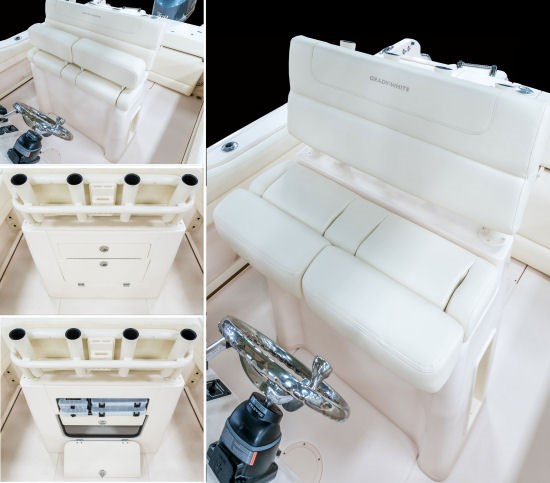
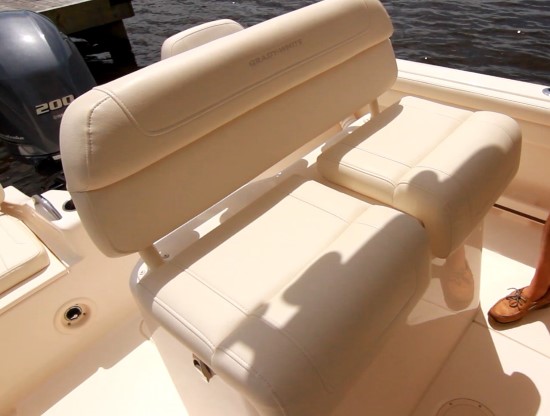
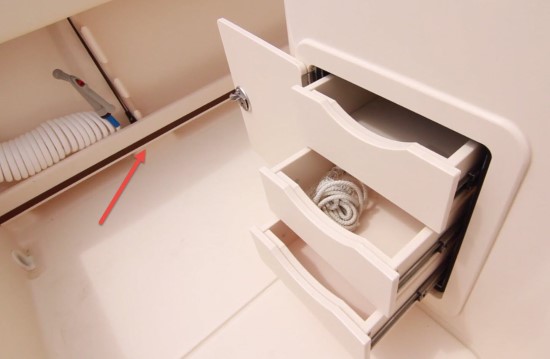
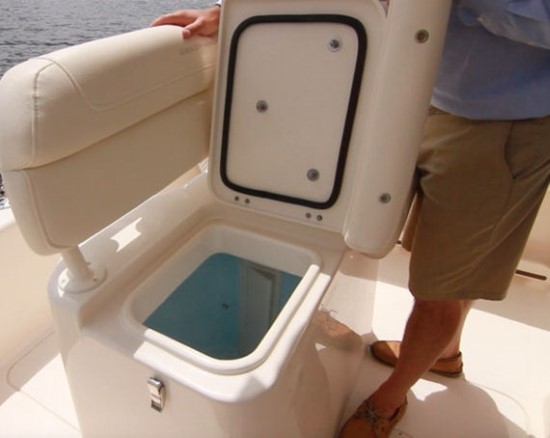
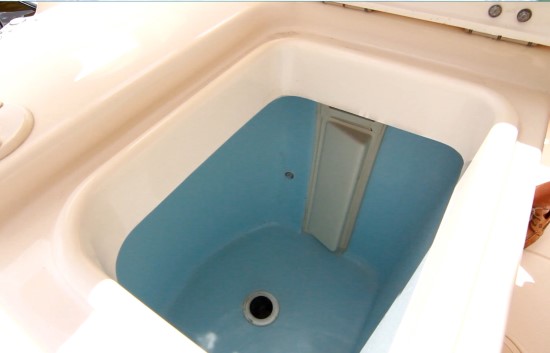
The Head Compartment
Family boating demands some creature comforts. With that in mind, the Fisherman 216 comes standard with a portable head unit that can be upgraded with a deck pump out or an in-line macerator. The console interior is ventilated and comes complete with a mirror, storage hook, lighting, and a window with screen.
The inside of the head compartment is a complete fiberglass liner; an important detail that separates the Fisherman 216 from lower-priced boats. These liners are easy to keep clean and look good.
The Toilet. Our test boat had this optional toilet with an in-line macerator; offshore fishermen will prefer this, since they can pump it when beyond the three-mile limit. A basic portable toilet is legal everywhere since it has an integral holding tank, which is about the size of a rigid briefcase. It is designed to be taken off the boat and dumped in a toilet ashore. Deck pump out is an option, and one we think is worth the price.
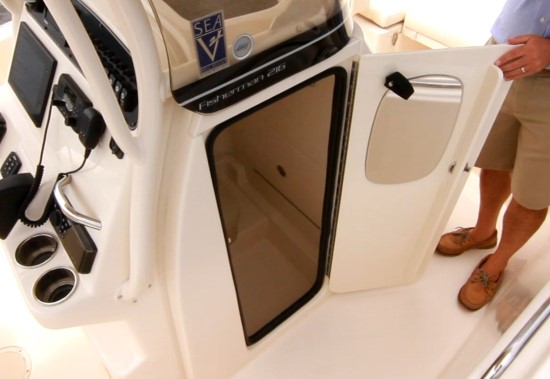
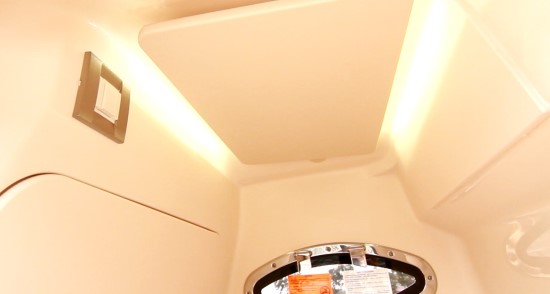
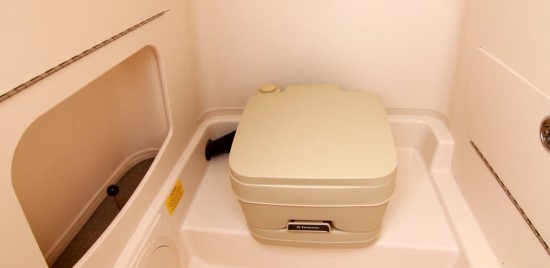
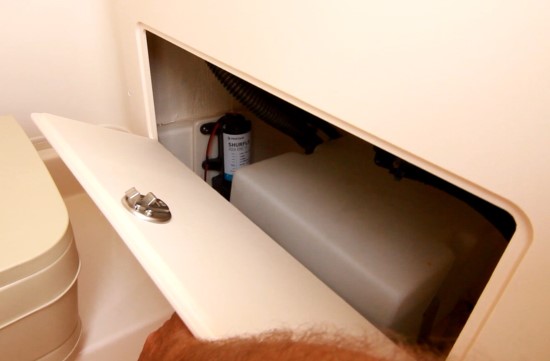
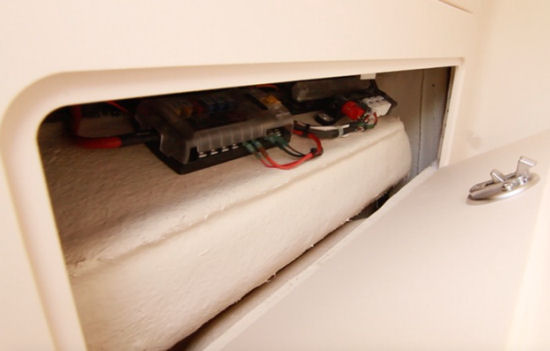
Optional T-top or Bimini?
Although it's an expensive option, we recommend that anglers add the fiberglass T-top to the Fisherman 216. If the mission of the 216 is limited to local casual boating activities and watersports, an optional Bimini top would serve just as well, or maybe even better. In any case, unless the boat will be used only at dusk or in the dark, we recommend getting some sort of UV protection.
Our test boat had the T-top, and we feel that for anglers it's worth the investment. It includes a full-height wraparound acrylic windshield -- welcome on cool days -- that adds handholds for moving around the boat and provides a surface to mount antennas, GPS receivers, and spreaders. It also houses stereo speakers, rocket launchers, and LED lights.
Less is More. There is more to this design of this T-top than meets the eye. It looks simple -- and that is one of the beauties of it -- and it is remarkably unobtrusive. Often the aluminum supports for the T-top are screwed to the deck and restrict passage somewhat, in addition to looking ugly. This T-top has supports that rest on the console itself. Another failing of T-top fabricators is to put the supports in the line of vision for the operator, with diagonal support bars. The optional T-top on the Fisherman 216 gets high marks in our book for affixing the aluminum supports to the center console and not to the deck, and for keeping forward vision clear.
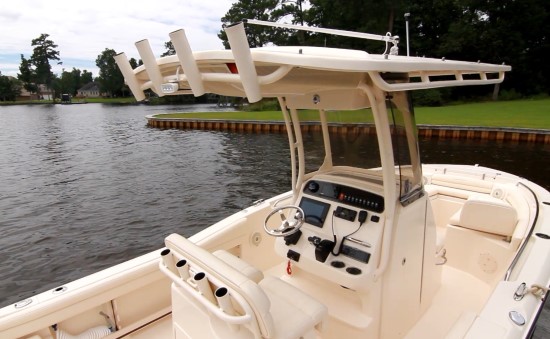
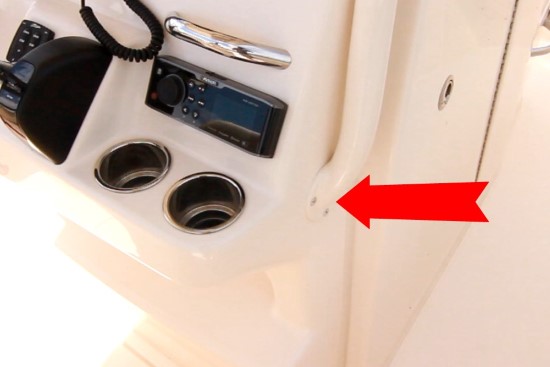
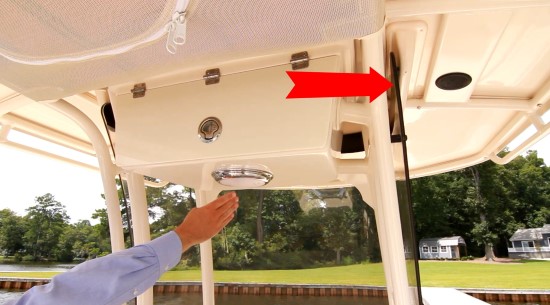
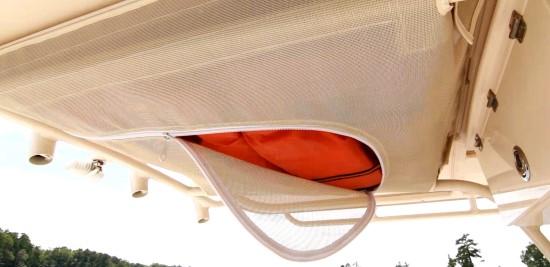
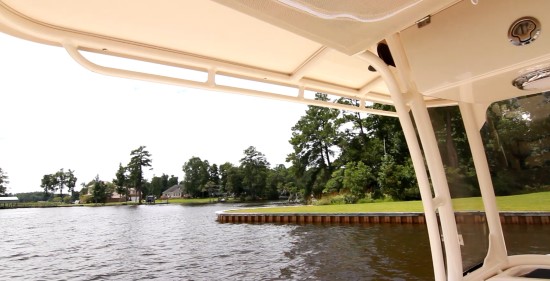
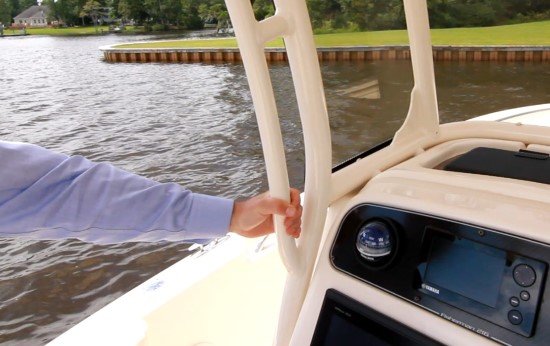
Forward Cockpit
One of the Fisherman 216's selling points is her family-friendliness, but maximizing that feature requires investing in the bow cushions and backrests, and maybe the filler cushion, too. Otherwise, the boat's forward cockpit is typical center console -- twin seats with insulated 81-quart fish/cooler boxes underneath. A molded, cushioned seat on the forward side of the console is standard, with a 25.8-quart cooler underneath.
With the addition of optional swiveling back rests, the Fisherman 216 is turned into a bowrider and can play that role just as well as -- or better than -- conventional sportboats. A filler cushion takes it the extra mile to create a large sun pad. Sans cushions, seat backs and pads, the bow makes an excellent casting platform as mentioned above.
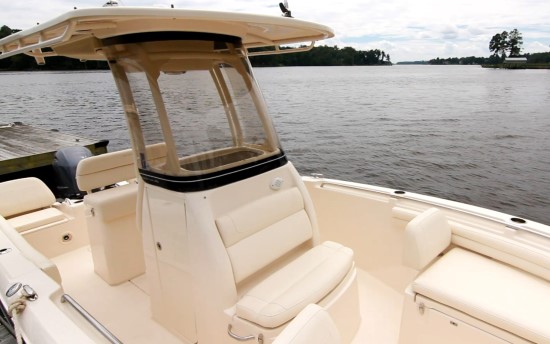
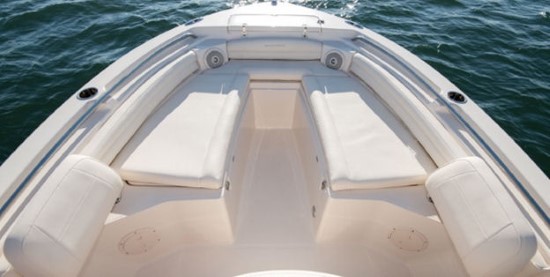
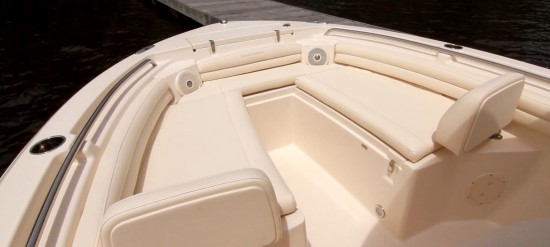
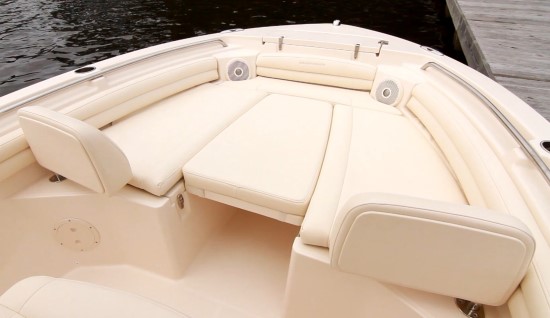
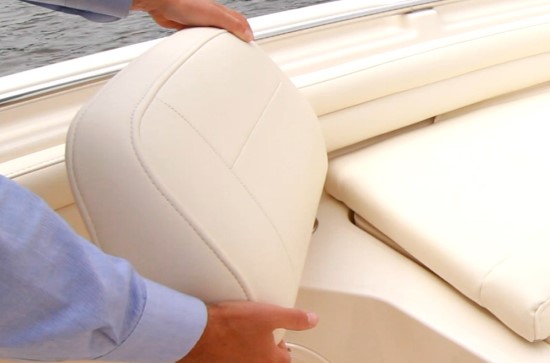
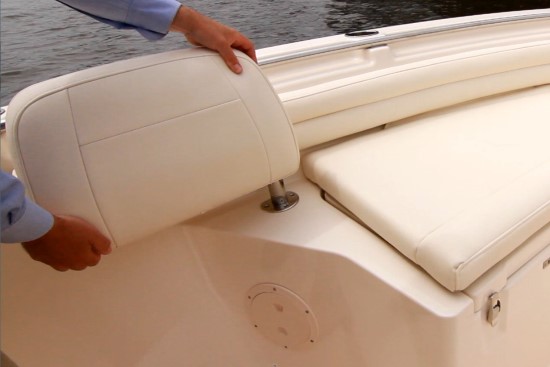
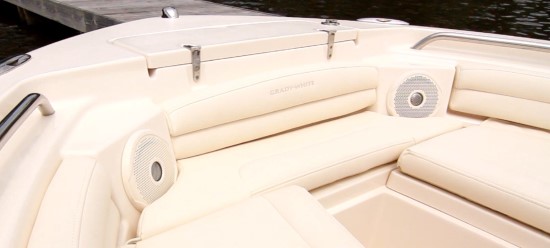
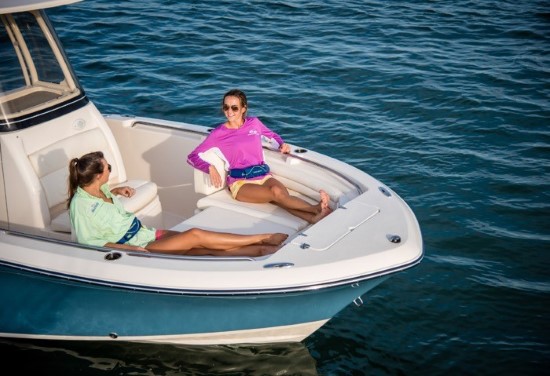
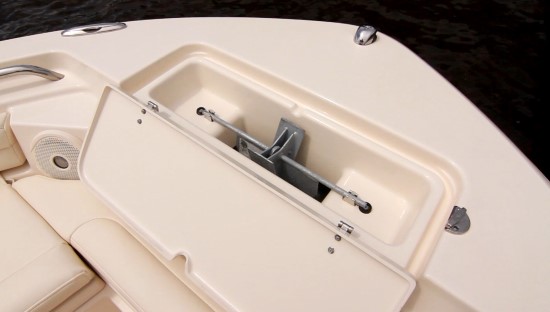
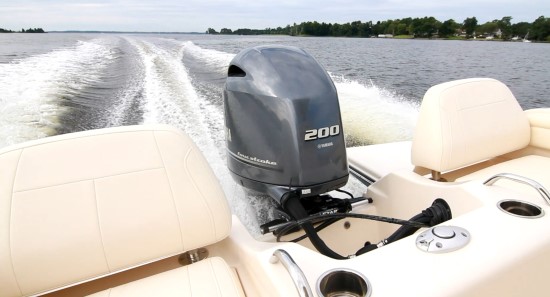
Performance
Standard power for the Fisherman 216 is a single 200-hp 2.8 L in-line 4-cylinder Yamaha outboard -- the engine we used for the test. The props were 14’1/2 x 15 Reliance SDS stainless steel units. Test day had an ambient temperature of 80-degrees, 70% humidity, light wind, and flat water in the river where we ran the boat. With two people aboard, we had an estimated test weight of 5,063 lbs. (2,296 kg).
Speed Data. Our test captain measured a top speed of 36.9 knots (42.5 mph) and a best cruise of 17.5 knots (20.2 mph) at 3500 rpm. At that speed, we burned 5.4 gph and were getting 3.2 nmpg (3.7 smpg), for a range of 233 nm (269 sm), keeping 10% of the 80-gallon (303 L) fuel capacity in reserve.
Most people we know will want to spend a few extra dollars on fuel and go faster, and at 4500 rpm, we recorded 27.4 knots (31.5 mph). At that speed, we burned 9.4 gph, got 2.9 nmpg (3.4 smpg) for a range of 209 nm (241 sm) with a 10% reserve.
250-hp Data. Grady-White includes on their website Yamaha test data with the 250-hp Yamaha 4.2 L V6 Yamaha. The reported top speed was 42.5 knots (48.9 mph) and a best cruise speed of 19.4 knots (22.4 mph) at 3000 rpm. There, the engine burned 9.9 gph for 3.14 statute miles per gallon.
Consumer Caveat: Yamaha Motors, for some reason, usually picks as its ideal cruising speed an RPM that is not the most fuel efficient. It is usually at the speed where most people like cruising in smooth water. Typically, the most fuel-efficient RPM setting on outboard engines in this horsepower range is 3500. On this particular engine (the 250 Yamaha), the most efficient RPM setting is reported to be at 3000.
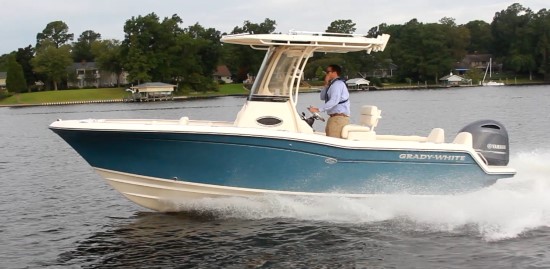
Hole Shot Times. We recorded a time to plane of our test boat of 4.8 seconds. Time to 20 mph was 6.4 seconds, and time to 30 mph was 10.2 seconds.
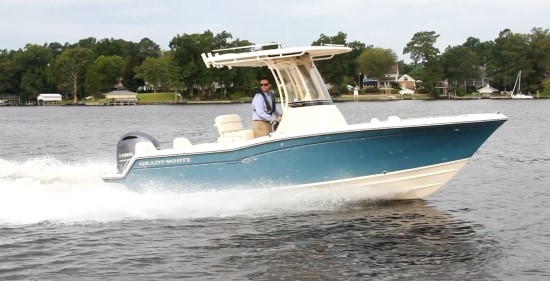
Handling
On a hard turn, the Grady-White SeaV2 hull digs in for secure tracking, while the chines throw the spray low and away from the hull. Turning was docile, aided by the steering knob. We punched through the photo boat’s wake without pounding. At rest, the boat was relatively stable.
Which Engine to Choose?
As far as the brand of engine goes, there is only one choice -- Yamaha. Those who prefer another engine brand will have to buy another boat brand. When it comes to which horsepower engine to choose – the 200-hp or the 250-hp Yamaha -- we’d say it depends on how the boat is going to be used. The hardcore will go with the larger engine, but most people really don’t need that much power for coastal and protected water work -- which is the primary mission of this vessel. We think far too much emphasis is placed on top speed by most consumers. They will rarely go the top speed, even if conditions permit.
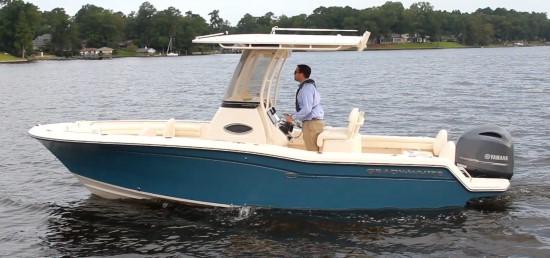
Hull Colors
For decades, Grady-White had one hull color, an off-white cream color that is distinctive. It served the company well, and the color along with its trademark Rybovich sheer line made the Grady-White boats obvious a mile away. A few years ago, the builder introduced a set of optional colors, one of which is shown in the picture above. See our video for the other colors.
We have always liked the Grady-White sheer and think that it is even more pronounced-looking when the hull is a color.
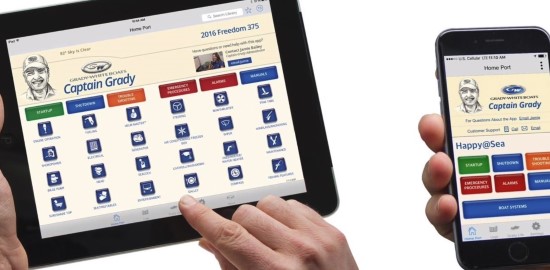
Observations
We are often asked why Grady-White boats cost more than many of the low-priced brands on the market. The simple answer is that most of those brands are built by a one-man band -- in many cases someone who has learned how to laminate boats and started a boat company. Usually, this fellow is chief cook and bottle washer. He is the designer, engineer, construction foreman, general manager, and CFO. Typically, these brands are short on engineering staff, skilled equipment installers, QC inspection, to say nothing of customer service departments and standards compliance personnel.
For example, we recently inspected a popular low-priced model that had only one clamp on a hose connected to a thru-hull fitting below the waterline. We suspect that this was done, not to save a few cents, but because the installer didn’t know any better, and there was no adequate QC. There is much more to boats than resin, fiberglass, and an outboard motor.
Grady-White boats are not for everyone. Many people live on canals and just like to have a boat available to cruise on the ICW or other protected water and not go far from home. Many people do not really do much with their boats, so they are never put to the test, and if problems occur they are not far from shore.
On the other hand, there are boaters who want to take their small boats offshore for serious fishing, and in the case of the Fisherman 216, have a boat that can serve other functions for the whole family in comfort and without compromise. All of this without having to worry about whether the builder did everything right, followed ABYC and CE standards, used best practices in all systems and construction details, and has the engineering and customer support staff to back it all up. These people want a boat that looks beautiful and signals that they know the difference between a well-built boat and one whose main feature is simply a low price. These are the people for whom Grady-White is building boats.

